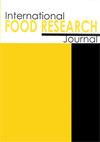草药混合物强化木薯粉的物理特性和血糖反应
IF 1
4区 农林科学
Q4 FOOD SCIENCE & TECHNOLOGY
引用次数: 0
摘要
由于面条的血糖反应相对较高,大量食用面条与生殖疾病的风险增加有关。含有高酚类化合物的植物可以减少富含碳水化合物的食物的血糖反应。因此,本研究旨在评估用姜黄(T)、肉桂(C)和番石榴叶(G)粉混合强化的木薯粉的物理特性和血糖反应。药材配比(T: C: G)为0.00:0.00:0.00 G (C1);1.00: 0.50: 1.50 g (C2);1.33: 0.67: 1.00 g (C3);1.67: 0.83: 0.50 g (C4);和2.00:1.00:0.00 g (C5)。混合草药可提高面条中总酚和类黄酮含量。抗拉强度高的面条由于吸水率低而较硬,肿胀程度低,但配方对吸油率的影响不同。血糖水平曲线下面积(AUC)显示,C2面条面积最小(2321单位),C1面条面积最小(3066单位),C5面条面积最小(3241单位),但差异无统计学意义,这表明健康志愿者食用这些面条时的血糖反应与原始面条相似。本文章由计算机程序翻译,如有差异,请以英文原文为准。
Physical properties and glycaemic response of tapioca noodles fortified with herb mixture
High noodle consumption is associated with an increased risk of generative diseases due to noodles' relatively high glycaemic response. Plants containing high phenolic compounds can reduce the glycaemic response of carbohydrate-rich foods. The present work thus aimed to evaluate the physical properties and glycaemic response of tapioca noodles fortified with a mixture of turmeric (T), cinnamon (C), and guava leaves (G) powder. The proportions of herbs (T: C: G) were 0.00: 0.00: 0.00 g (C1); 1.00: 0.50: 1.50 g (C2); 1.33: 0.67: 1.00 g (C3); 1.67: 0.83: 0.50 g (C4); and 2.00: 1.00: 0.00 g (C5). Herb mixtures increased the total phenolic and flavonoid contents of the noodles. Noodles with higher tensile strength (TS) were harder and less swollen because the water absorption capacity (WAC) was lower, but effect of the formulas on the oil absorption capacity (OAC) varied. Area under the curve (AUC) of blood sugar levels showed that C2 noodles had the smallest area (2,321 units) as compared to C1 (3,066 units) and C5 (3,241 units) noodles, but the difference was not statistically significant, thus indicating that the glycaemic responses of these noodles were similar to that of the original noodles when consumed by healthy volunteers.
求助全文
通过发布文献求助,成功后即可免费获取论文全文。
去求助
来源期刊

international food research journal
Agricultural and Biological Sciences-Food Science
CiteScore
1.40
自引率
0.00%
发文量
75
期刊介绍:
The International Food Research Journal (IFRJ) publishes papers in English, six (6) issues a year with the coverage of:
Food Science and Technology
Nutrition and Dietetics
Agriculture, multidisciplinary
Chemistry, multidisciplinary
The scope of the Journal includes:
Food Science, Food Technology and Food Biotechnology
Product Development and Sensory Evaluation
Food Habits, Nutrition, and Health
Food Safety and Quality
Food Chemistry, Food Microbiology, Food Analysis and Testing
Food Engineering
Food Packaging
Food Waste Management
Food Entrepreneur
Food Regulatory
Post-Harvest Food Management
Food Supply Chain Management
Halal Food and Management
 求助内容:
求助内容: 应助结果提醒方式:
应助结果提醒方式:


